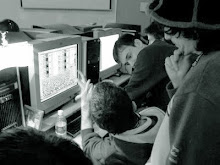Monday, November 5, 2007
The Proof of Concept
The Objective: Team Work
The Proof of Concept was an exercise in team work. Having taught for many years, I found that giving individual assignments just didn't represent the real production world of collaboration. In some circumstances, I observed that independent studies did little more than fuel the 'brillant artist myth' of one person doing it all. As animators, I think it's natural that we have this tendency to curl up in our little corners, slap the headphones on and shut the real world out as we create our own.
I also needed the students to experience what it was like to take an idea from the page and turn it into a 3d animation. My objective, was to accomplish this in a condensed 7 week project so that they could use this information to better plan their demo reels.
The Context: Kids Books
The students were broken up into small teams of 4-5 people chosen completely at random. Each team was given a page from an illustrated children's book. I would change the book every few terms to keep the material fresh. The guidelines were quite simple, use the original art work as a conceptual starting point and illustrate the meaning of the page through a 30 second 3D animation.
I chose kids books for the reason that the illustrations are often simple, straightforward and highly effective. I find that most 3D artist tend to over complicate things. I also wanted to expose my students to a different genre of animation. With many of my students pitching me large breasted heroine characters with over sized swords, I thought some good old preschool images would help temper the hormones.
The Results: Do they Matter?
Well that depends on who you ask, but to be truthful, I didn't expect much in terms of the final results. Experience wise, my students had only been in the program for two terms (4 months) and for the most part, had never put a complete project together. Add to this fact that term 3 has a notoriously insane workload, I would have been happy if they simply met their deadlines without killing one another.
The results have been nothing short of impressive, both in the work and the collaborations. Time and time again, the students have impressed me with their ideas, execution and ability to work together. But don't take my word for it, click on the projects too see for yourself.
Thanks to all my students for their work and dedication.
Process - Don't make me go there!
If there's one thing my students love to talk about it's the techno-whoey. As much as I might to try and cram story down their throats, the discussion always seems to come back to the technology and I'll be the first to admit that I'm guilty of it too.
This proof of concept was based on the book, "Sometimes I like to Curl up in a Ball" by Vicki Churchill and Charles Fuge about a little Wombat's busy day of adventures. This team was asked to focus on the environment. If memory serves me right, I asked them to make the best grass they could. I didn't care how they were to achieve it, as long they made their deadline. Being 3D students they took the technical route and decided to use dynamics and simulations to achieve their shot.
With barely seven weeks to complete the project, the students were given weekly deadlines so we could discuss their progress. We work in the context of an animatic as soon and as often as possible to ensure that the focus of the criticism is on the shot and not just the technology. I encourage them to show me everything, even their mistakes. Sometimes seeing the mistakes makes for a good academic discussion and other times its just funny.
What I remember most about this team was their ability to have work and questions at every weekly review. As a result, our discussions felt more like production and my energy could be put into critiquing the work, as opposed to lecturing about the importance of process (trust me, I can go on and on about that one). In short, these guys nailed it. Their advice on adding grass as a background element after figuring it out, "Don't do it. It's a lot of work." I take it they had a few late nights on this one.
Girl Power
For the most part, when I create the student groups my approach is completely random. My philosophy is that you often don't get to choose who you work with in the real world, so why should you have that luxury in school. However, with this group my picking was a little less random; I put all the female students into one group. I think part of it was my surprise that there was actually more than one girl in the class. The other side of it was to create a little bit of rivalry amongst the sexes - let's see if the girls can put the boys in their place.
The first task the teams have is to define roles and responsibilities. The responses are usually quite straightforward, with the work being split out into the separate crafts. This person is the modeler, this person the animator, this one the texture artist, etc. The girls however, took a much more democratic approach to the work. Rather than splitting the task into specialties, they decided that everyone would do an equal amount of the work with each person in the group identified as the a 'lead' in their area of expertise. Depending on where they were in the production cycle, a different person would be leading the work. As a result, everyone was exposed to all aspects of the pipeline with support coming from everyone on the team. Their decision to work this way was completely academic as they felt the learning experience was more important than the outcome.
The results? Well you can judge for yourself, but considering that a huge part of this exercise is to learn how to collaborate, I think these girls not only did well, they broke the mold.
Here's their org chart for this project.

Simplicity in Design
This project was based on the book, "Dim Sum for Everyone", by Grace Lin about dim sum, the Chinese tradition of eating tiny dishes of food (much like a tapa) along side tea. Growing up, my family called it 'yum cha', which translates literally to 'drink tea'.
As I always like to mix things up, I made the students approach this project a little differently. In short I made it more like an 'art school' project' and asked them to give their interpretation of dim sum through a thirty second animation. The first task was to go 'yum cha' with their team mates and use that experience as a jumping off point. There were some great responses including a special appearance by famed 'Piece of Mind' director Ori Ben-Shabat in drag (Ori, you gotta' shave those arms).
I chose to post the group of David Igo, Steven Chen and Ljubomir Milic who's response was a shining example of an intelligent art direction that addressed their weakness by playing it as a strength. Being modelers, and I'm paraphrasing here, they said, "We can't animate". True - they couldn't 'animate'. My advice in this situation is to go for a style that will allow you to simplify the animation, thus matching the skill level of your team.
Wanting to temper the amount of animation, they chose a simple cut-out style for the look.This made their asset creation phase move fast, giving them more time to spend on other areas of the project.
The end result tells a great story and although they said they couldn't animate in the end they did. Excellent work boys!
Boy on a Hill Top
I found this book at the local used book shop and was immediately taken by its illustrations. The book is printed on a heavy stock with lots of tooth that gives the feeling that each page is a painting. Having run the group assignments in six groups of five, I felt what we needed was not only a new book, but a new approach to the team project. So being the instigator I enjoy being, I made class 56 do this as one large crew - the entire class working as a unit to complete the book from beginning to end, keeping close to the vision of the original art work and story.
My first class with the students is the lecture introduction to the course and review of past student work. I always wait until the very end to introduce the illustrations and assigned teams. By this point, I've usually got them hooked into the idea and they're excited to find out their groups. When I announced that they would be doing it as one team they were all kind of shocked. I later learned in the lab through the other classes that there was quite the drama brewing around this project. Ahhh... the sound of production.
Class 56 rose to the occasion. Hats off to all of you!
Peace,
Casey
Subscribe to:
Posts (Atom)

